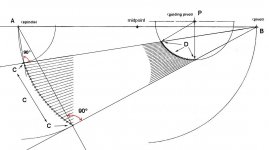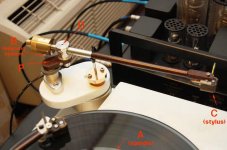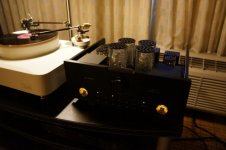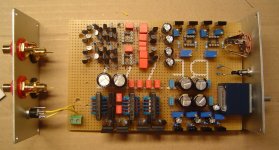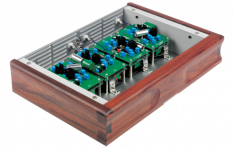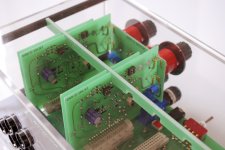Frank Schroeder won the turntable shootout. And yes, Berlin is confirmed.
jan
He said on preparation it is necessary to have the winning player, not the "best" one.
Headwise EQ, SG phonopre stage
I take notice of all your recomending notices, your tips are very helpfull, thanks
Yes, that equalizer will work with some modifications. Just shift the midrange EQ to 3kHz,
the bass EQ a little deeper and the treble EQ up to over 10kHz. As far as i can tell you should only change the values of the caps. So in the midrange you should use 1/3rd of the value that is given for example. Just put this circuit behind my input stage. You can take even out the inverter but then you have to revers your speakers.
I take notice of all your recomending notices, your tips are very helpfull, thanks
I listened to the Tanzmusik today and also obtained some curves. I had already checked out the bass tone regulator. The sound can be changed from tight, dry and fast to full, fat and groovy.
Good. The treble tone regulator i listened to today is also very interesting. The sound can be changed from somewhat dark to very bright. In the full on position the sound is extremely open with a lot of details. Yes, it is very bright but interestingly not sharp or hard. I found from my experience with speakers that this sharpness comes more from having too much around 5 kHz and this treble tone EQ works more on the overtones. Ultimately to advance the treble control to maximum is a bit confusing and tiring but i could imagine that it can blow life into a very dark recording or one that uses less then 75usec for EQ, for example recordings that are made to DIN standard that is 50usec, when it is used in moderation.
Also shown is a bass boost switch i added that gives about 1dB plus at 20Hz. A supple effect. The input transformer has a zobel network that can be optimized to the impedance of the cartridge in use. I have 2 Ohm, 6 Ohm and 20 Ohm positions. It also can be switched of. As you see the effect is again supple. I will publish some square wave responses where you can see the effect better.
As you may have noticed the response in the RIAA position is a bit down ( -0.5dB ) at 20kHz. That is because i over damped the input stage a bit. I need a 2.2nF cap but i fitted a 3.3nF. I will change that. When you move the EQ potmeters the gain also changes a bit. This effect is not shown because i normalized the curves. I will show the real curves overlaid in my next post.
Good. The treble tone regulator i listened to today is also very interesting. The sound can be changed from somewhat dark to very bright. In the full on position the sound is extremely open with a lot of details. Yes, it is very bright but interestingly not sharp or hard. I found from my experience with speakers that this sharpness comes more from having too much around 5 kHz and this treble tone EQ works more on the overtones. Ultimately to advance the treble control to maximum is a bit confusing and tiring but i could imagine that it can blow life into a very dark recording or one that uses less then 75usec for EQ, for example recordings that are made to DIN standard that is 50usec, when it is used in moderation.
Also shown is a bass boost switch i added that gives about 1dB plus at 20Hz. A supple effect. The input transformer has a zobel network that can be optimized to the impedance of the cartridge in use. I have 2 Ohm, 6 Ohm and 20 Ohm positions. It also can be switched of. As you see the effect is again supple. I will publish some square wave responses where you can see the effect better.
As you may have noticed the response in the RIAA position is a bit down ( -0.5dB ) at 20kHz. That is because i over damped the input stage a bit. I need a 2.2nF cap but i fitted a 3.3nF. I will change that. When you move the EQ potmeters the gain also changes a bit. This effect is not shown because i normalized the curves. I will show the real curves overlaid in my next post.
Attachments
-
Tanzmusik Transformer Zobel 2 Ohm - red 6 Ohm - light blue 20 Ohm black Off - dark blue.pdf15.3 KB · Views: 82
-
Tanzmusik RIAA - black Bass Boost On - red.pdf15.4 KB · Views: 97
-
Tanzmusik Bass Tone full on - red full off - black.pdf16.3 KB · Views: 73
-
Tanzmusik Treble Tone full on - red full off -black.pdf16.6 KB · Views: 100
Here are the overlaid curves:
RIAA - black
Bass Tone - full up and down
Treble Tone - full up and down
There is some gain dependency around 1kHz, but not much, i think this works very well and i can not hear noise when i turn the pots. This is even better.
RIAA - black
Bass Tone - full up and down
Treble Tone - full up and down
There is some gain dependency around 1kHz, but not much, i think this works very well and i can not hear noise when i turn the pots. This is even better.
Attachments
I dont think the servo has to be fast....unless you want to change while playing...
I was thinking to run a pot and a resistor in parallel with a resistor and then having the pot closed and pot open defining the two ends of the adjustments...thenIi can adjust the two poles to fit the different de'emphasis curves
I was thinking to run a pot and a resistor in parallel with a resistor and then having the pot closed and pot open defining the two ends of the adjustments...thenIi can adjust the two poles to fit the different de'emphasis curves
here is my starless build..... everything on one PCB. Upper left corner are the two "starless" channels, upper right corner is the headphone amp. Lower left is the input rectifier and filters, bottom row are the four current sources and shunt regulators.
52 TO92's in total, plus 12 power discretes and four opamps... not sure I ever put that many discretes in a circuit.....
And, I can report the first functionality - the power LED already lights up ;-) more later as I didnt have enough time to hook it all up and try it out.....
52 TO92's in total, plus 12 power discretes and four opamps... not sure I ever put that many discretes in a circuit.....
And, I can report the first functionality - the power LED already lights up ;-) more later as I didnt have enough time to hook it all up and try it out.....
Attachments
here is my starless build..... everything on one PCB. Upper left corner are the two "starless" channels, upper right corner is the headphone amp. Lower left is the input rectifier and filters, bottom row are the four current sources and shunt regulators.
52 TO92's in total, plus 12 power discretes and four opamps... not sure I ever put that many discretes in a circuit.....
And, I can report the first functionality - the power LED already lights up ;-) more later as I didnt have enough time to hook it all up and try it out.....
Well! You're not one to take the easy way out
jan
There are two excellent Veroboard builders that I am aware of :
Kaneda (all layouts in his books ar eVerobiard based),
http://www.amazon.co.jp/完全対称型オーディオDCアンプ―音楽ファンに捧げる自作オーディオ-2004‐2008年厳選10機種-金田-明彦/dp/4416108079
and Evolve Power Amps :
Evolve Power Amplifiers
Patrick
Kaneda (all layouts in his books ar eVerobiard based),
http://www.amazon.co.jp/完全対称型オーディオDCアンプ―音楽ファンに捧げる自作オーディオ-2004‐2008年厳選10機種-金田-明彦/dp/4416108079
and Evolve Power Amps :
Evolve Power Amplifiers
Patrick
